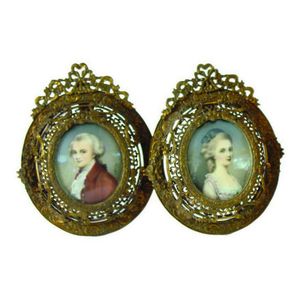Worcester Soft Paste Plates, 18th Century
You must be a subscriber, and be logged in to view price and dealer details.
Subscribe Now to view actual auction price for this item
When you subscribe, you have the option of setting the currency in which to display prices to $Au, $US, $NZ or Stg.
- Circa - A Latin term meaning 'about', often used in the antique trade to give an approximate date for the piece, usually considered to be five years on either side of the circa year. Thus, circa 1900 means the piece was made about 1900, probably between 1895 and 1905. The expression is sometimes abbreviated to c.1900.
- Soft Paste Porcelain - Porcelain is an ancient ceramic material, first made in China, hence the common name "china", and the process was unknown in the West.
European potters attempted to replicate Chinese porcelain, without knowing the ingredients in its composition, and the earliest wares were produced with mixtures of clay and ground-up glass (frit), the idea being that the glass would give the porcelain translucency.
It was given the name "soft" because it did not remain rigid, but "slumped" when fired in the kiln at high temperatures. - Marbling - A descriptive term for a finish applied to plastic, ceramics, glass, plaster or wood to imitate the colours and characteristic markings of various marble types. For moulded items such as the first three above, the marbling is within the item.
Interiors and furniture were marbled from from the early 17th century to the late Victorian period. The craft was practiced by skilled decorators using a combination of brushes and sponges. Some of the finishes achieved were so realistic as to make it difficult to distinguish the marbled surface from the marble surface.
Marbling is also a term applied to a finish for paper as often seen in the front and endpapers of old books. The marbling is achieved by floating the colours on water and then transferring them to paper. However the marbling finish on paper, as with the marbling finish on plastics, with its multitude of colours has little resemblance to naturally occurring marble. - Gilding - Gilding is a method of ornamentation whereby a thin sheet of gold metal is applied to items made of wood, leather, ceramics, glass and silver for decorative purposes.
For furniture including mirrors, the sheet of gold is usually applied over a coating of gesso. Gesso is a mixture of plaster of Paris and gypsum mixed with water and then applied to the carved wooden frames of mirrors and picture frames as a base for applying the gold leaf. After numerous coats of gesso have been applied, allowed to dry and then sanded a coat of "bole", a usually red coloured mixture of clay and glue is brushed on and allowed to dry, after which the gold leaf is applied. Over time parts of the gilding will rub off so the base colour can be seen. In water gilding, this was generally a blue colour, while in oil gilding, the under layer was often yellow. In Victorian times, gilders frequently used red as a pigment beneath the gold leaf.
Metal was often gilded by a process known as fire gilding. Gold mixed with mercury was applied and heated, causing the mercury to evaporate, the long-term effect of which was to kill or disable the craftsman or woman from mercury poisoning. The pursuit of beauty has claimed many victims, not the least of which were the artists who made those pieces so highly sought after today.
This item has been included into following indexes:
Visually similar items

A pair of Sevres porcelain cabinet plates, decorated with hand painted portrait medallions of Marie Antoinette and the Duchess de Bourgogne, each within raised gilt borders and floral panels on an ivory ground; Chateau des Tuileries mark to reverse. Diamet

A Bloor Derby plate, Kirkstall Abbey Yorkshire. It is together with a similar plate pattern 1183, each with a painted landscape within a blue border with gilt and a scalloped gadrooned border. 23 cm, 25 cm

Three Chinese porcelain plates, Qing dynasty, circa 18th century, one painted with two ladies in a pavilion, the other two are octagonal in shape, one painted with court officials, the other painted with a court lady and attendants, 23.1 cm diameter (large

A pair of early/mid 20th century portrait miniatures in gilt glass frames of Mozart and his companion, in formal dress, signed Cosway
